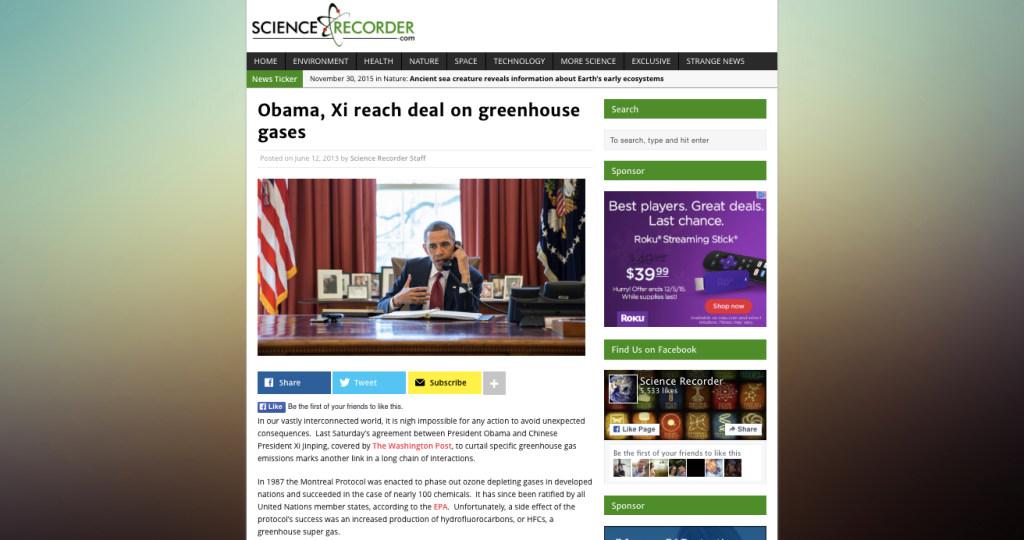Published by Science Recorder | June 2013
by L. Clark Tate
In our vastly interconnected world, it is nigh impossible for any action to avoid unexpected consequences. Last Saturday’s agreement between President Obama and Chinese President Xi Jinping, covered by The Washington Post, to curtail specific greenhouse gas emissions marks another link in a long chain of interactions.
In 1987 the Montreal Protocol was enacted to phase out ozone depleting gases in developed nations and succeeded in the case of nearly 100 chemicals. It has since been ratified by all United Nations member states, according to the EPA. Unfortunately, a side effect of the protocol’s success was an increased production of hydrofluorocarbons, or HFCs, a greenhouse super gas.
HFCs are a class of synthetic chemicals used in refrigerators, air conditioners, insulating foams, solvents, and aerosol products. Currently HFCs account for a scant 2% of greenhouse gases emitted. That number is projected to grow to almost 20% by 2050 due to burgeoning global affluence that could expand the demand for air conditioners.
The EPA reports that HFCs cause 140 to 11,700 times as much warming as an equivalent amount of carbon dioxide over the course of 100 years. Thus, experts believe that targeting HFCs could reduce greenhouse emissions by an amount equal to 90 gigatons of carbon by 2050. That is equivalent to a full two years’ worth of greenhouse emissions at today’s rates.
The result of a four year negotiation effort, Presidents Obama and Xi agreed to reduce HFC emissions using the preexisting Montreal Protocol’s framework, and a step lauded as an effective one.
“This is a big deal. Obama deserves a lot of credit for this. He said he would tackle climate change, and this is really an important achievement,” enthused John Podesta. Podesta, the chairman of the left leaning Center for American Progress think-tank, added that experts at his organization believe that this could reduce end of the century global temperature projections by 0.5 degrees Celsius.
President of the Institute for Governance and Sustainable Development, Durwood Zaelkie has long advocated for this policy move. “The China-U.S. agreement on phasing down HFS under the Montreal Protocol will provide the single biggest, fastest, cheapest, and most secure piece of climate mitigation available to the world through 2020,” stated Zaelkie.
Although almost 100 other countries and the US had already pledged to reduce their dependence on HFCs, China’s pledge is considered pivotal. China is the biggest market for HFCs with potential for considerable growth due to rapidly growing wealth and holds considerable bargaining power with holdouts such as India and Brazil. Suitable replacements for many HFCs are still unavailable and nearly 30 countries have yet to pledge their support.
The Post speculated that the wave of environmental activism catalyzed by severe air pollution in Chinese cities such as Beijing last winter may have helped facilitate this earth friendly pact. Perhaps even a cloud of smog can sport a silver lining, and spark unexpected events.

Leave a comment